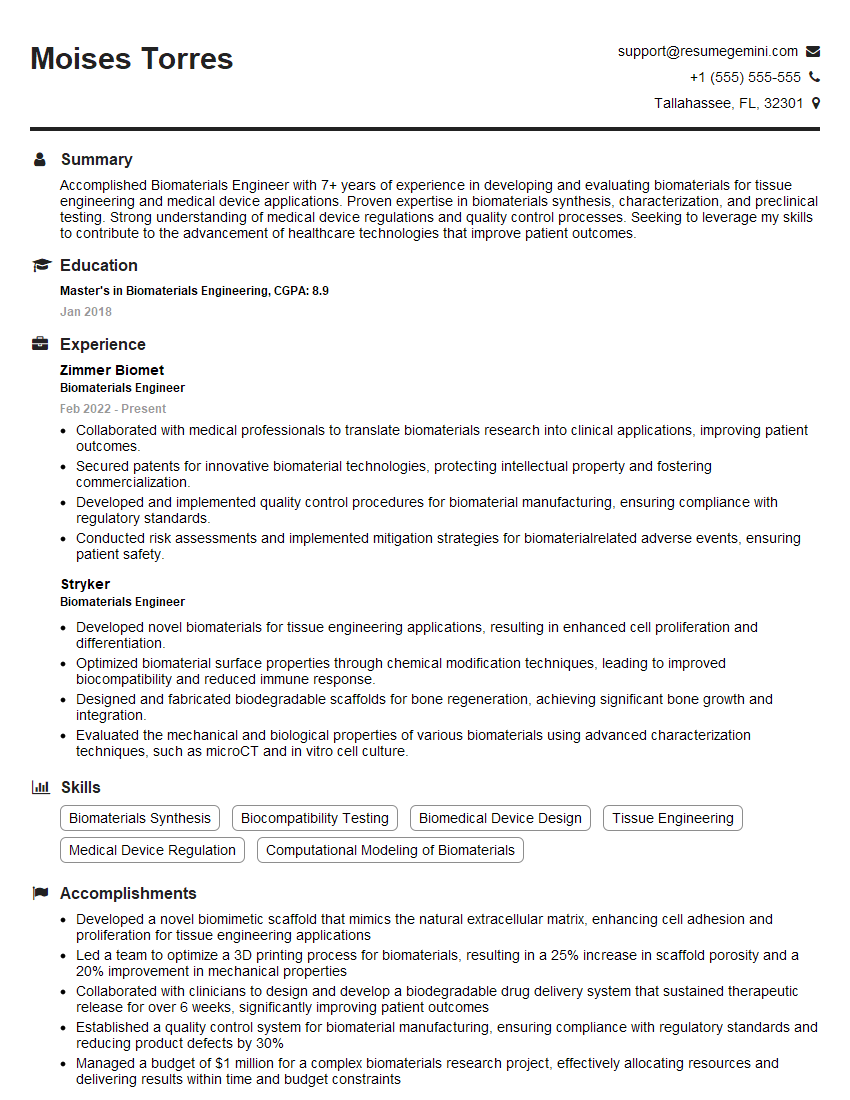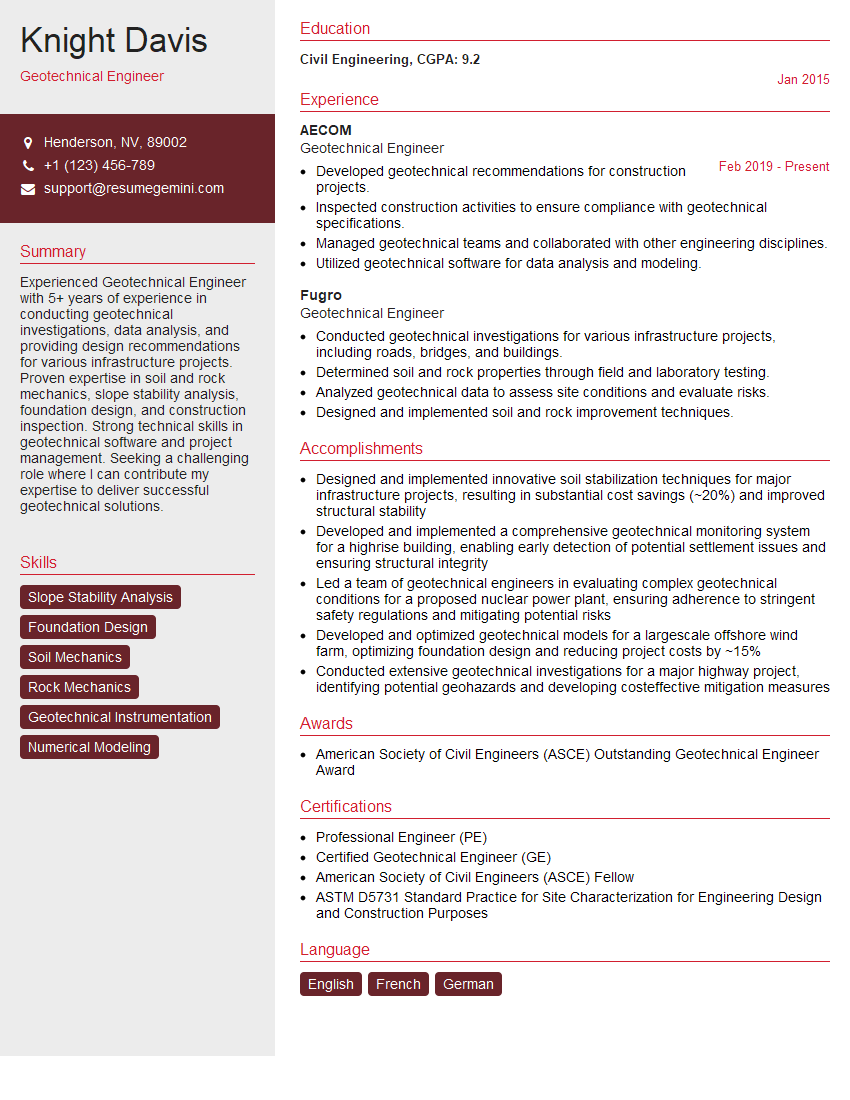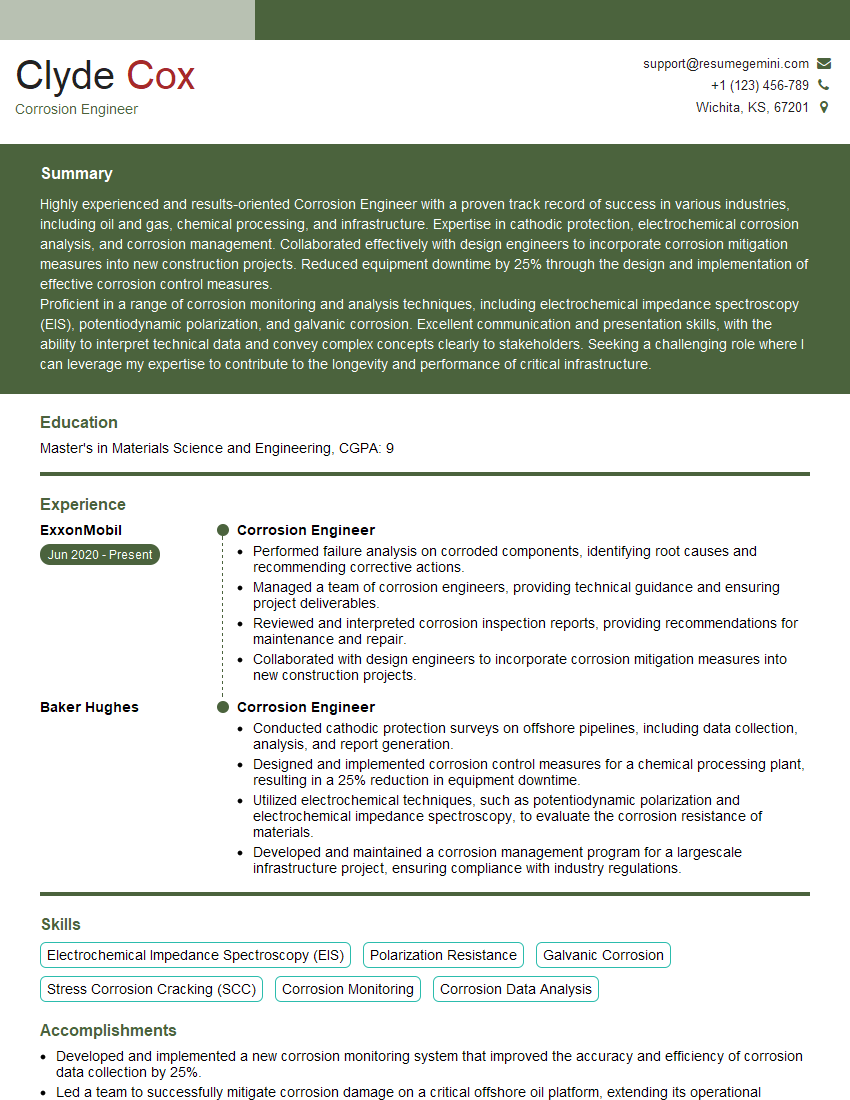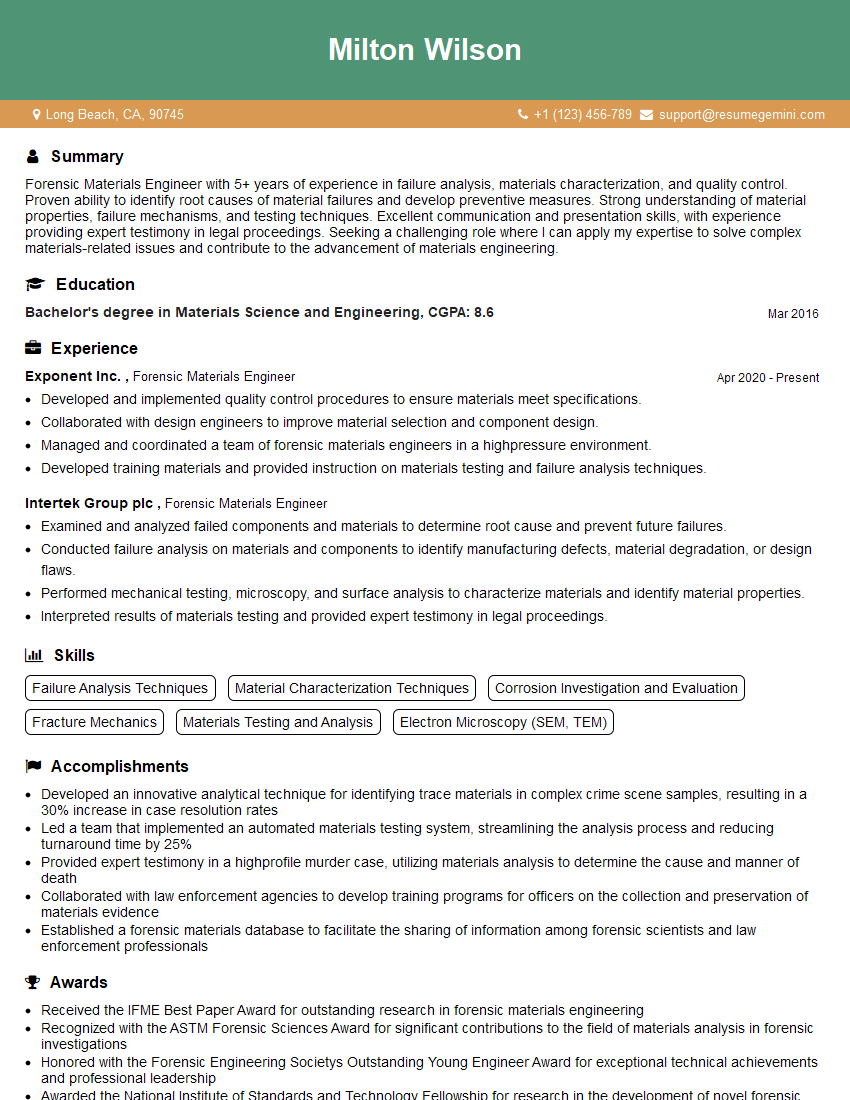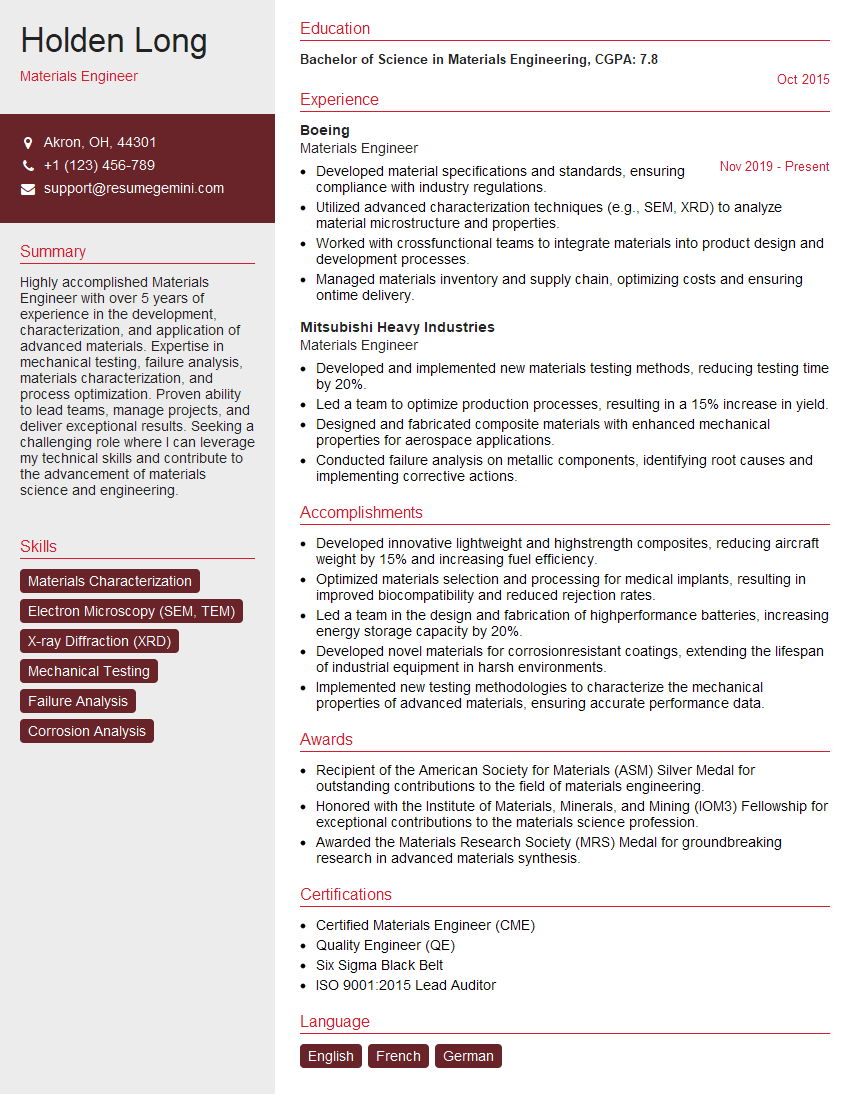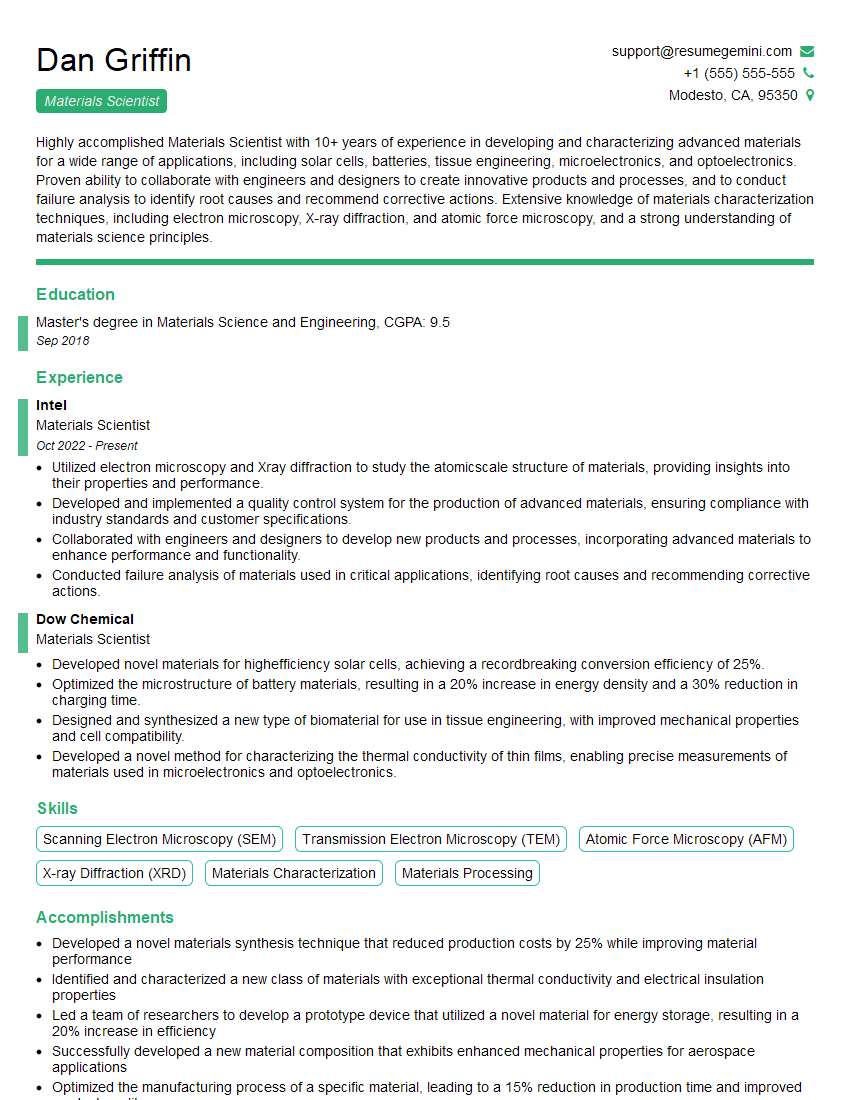Are you ready to stand out in your next interview? Understanding and preparing for Knowledge of Material Composition interview questions is a game-changer. In this blog, we’ve compiled key questions and expert advice to help you showcase your skills with confidence and precision. Let’s get started on your journey to acing the interview.
Questions Asked in Knowledge of Material Composition Interview
Q 1. Explain the difference between tensile strength and yield strength.
Tensile strength and yield strength are both crucial mechanical properties describing a material’s resistance to deformation under tensile stress, but they represent different points on the stress-strain curve. Tensile strength is the maximum stress a material can withstand before it fractures. Think of it as the ultimate breaking point. Yield strength, on the other hand, represents the stress at which the material begins to deform plastically – meaning the deformation is permanent and won’t recover upon removal of the load. It’s the point where the material starts to yield or permanently change shape.
Imagine stretching a rubber band. The tensile strength is the point where the rubber band snaps. The yield strength is the point where you start to stretch it, and it doesn’t return to its original length when you let go.
In engineering applications, knowing both is vital. For instance, designing a bridge requires a material with high tensile strength to withstand extreme loads without failure, and a high yield strength to ensure it doesn’t deform permanently under normal operating conditions.
Q 2. Describe the various types of non-destructive testing (NDT) methods used for material characterization.
Non-destructive testing (NDT) methods allow us to evaluate a material’s properties and identify flaws without causing damage. Several techniques exist, each with its strengths and weaknesses:
- Visual Inspection: The simplest method, involving a visual examination for surface cracks, corrosion, or other defects. Think of a mechanic visually inspecting a car part for damage.
- Liquid Penetrant Testing: A dye is applied to the surface, penetrating any cracks. After cleaning, a developer reveals the cracks as bright lines. Useful for detecting surface-breaking flaws in various materials.
- Magnetic Particle Testing: This method uses magnetic fields to detect surface and near-surface flaws in ferromagnetic materials. Magnetic particles are applied, and they accumulate at the flaw locations, making them visible.
- Ultrasonic Testing: High-frequency sound waves are used to detect internal flaws. The reflected waves reveal the presence, size, and location of defects. It’s like using sonar to map the ocean floor, but for material interiors.
- Radiographic Testing (X-ray/Gamma-ray): High-energy radiation passes through the material, creating an image on a film or detector. Denser areas appear lighter, revealing internal flaws like voids or inclusions.
- Eddy Current Testing: Electromagnetic induction is used to detect surface and near-surface flaws in conductive materials. Changes in the eddy current flow indicate the presence of defects. Commonly used in aircraft inspection.
The choice of NDT method depends on the material type, the type of flaw expected, and the access to the component.
Q 3. What are the common methods for determining the microstructure of a material?
Determining the microstructure of a material involves revealing its internal structure, which significantly influences its properties. Several techniques are employed:
- Optical Microscopy: A sample is polished and etched, then viewed under an optical microscope. This reveals grain boundaries, phases, and some microstructural features.
- Scanning Electron Microscopy (SEM): SEM uses a focused electron beam to scan the sample’s surface, generating high-resolution images. It provides much higher magnification and reveals finer details than optical microscopy.
- Transmission Electron Microscopy (TEM): TEM uses electrons transmitted through a very thin sample, allowing for visualization of the internal crystal structure at the atomic level. This technique provides the highest resolution for microstructure analysis.
- Electron Backscatter Diffraction (EBSD): A technique used in conjunction with SEM, it identifies crystallographic orientations within a material, providing detailed information about grain size, shape, and texture.
The selection of the appropriate method depends on the required resolution and the information sought. For instance, optical microscopy is sufficient for examining larger grain structures, while TEM is necessary for visualizing atomic-scale details like dislocations.
Q 4. How does the crystal structure of a metal affect its mechanical properties?
The crystal structure of a metal profoundly impacts its mechanical properties. The arrangement of atoms in a lattice directly influences strength, ductility, and other characteristics. For example:
- Grain Size: Smaller grains generally lead to higher strength and hardness due to increased grain boundary area, hindering dislocation movement (dislocations are crystal imperfections that contribute to plastic deformation).
- Crystal System: Different crystal structures (FCC, BCC, HCP) exhibit varying degrees of slip systems (planes along which atoms can easily slide past each other). Materials with more slip systems tend to be more ductile. For example, Face-centered cubic (FCC) metals like copper and aluminum are generally more ductile than Body-centered cubic (BCC) metals like iron.
- Crystal Defects: Point defects (vacancies, interstitial atoms), line defects (dislocations), and planar defects (grain boundaries, stacking faults) all affect the mechanical properties. Dislocations, for example, are responsible for plastic deformation, and their density influences the material’s strength.
- Texturing: Preferred orientations of grains can lead to anisotropic properties, meaning the properties vary depending on the direction. For example, a rolled metal sheet may have different yield strengths in the rolling direction and the transverse direction.
Understanding the relationship between crystal structure and mechanical properties is crucial in material selection and processing. For instance, heat treatments can be used to control grain size and thus manipulate the material’s strength and ductility.
Q 5. Explain the concept of phase diagrams and their use in materials selection.
Phase diagrams are graphical representations of the equilibrium relationships between different phases (e.g., solid, liquid, gas) of a material system as a function of temperature, composition, and pressure. They are essential tools in materials science and engineering.
For example, a binary phase diagram shows the phases present in a system composed of two components at different compositions and temperatures. These diagrams help predict phase transformations during heating or cooling, which is crucial for controlling microstructure and thus, properties. A common example is the iron-carbon diagram, used extensively in metallurgy to understand the various phases (austenite, ferrite, pearlite, etc.) in steel and their dependence on carbon content and temperature.
In materials selection, phase diagrams are invaluable because they:
- Allow us to predict the phases present at a given temperature and composition.
- Help select materials with the desired microstructure and properties.
- Guide the design of heat treatments to achieve specific microstructures (e.g., heat treating steel to achieve the desired hardness).
- Allow us to understand phase transformations and their effects on material behavior.
Essentially, phase diagrams serve as a roadmap for understanding and controlling material behavior during processing and application.
Q 6. Discuss the factors that influence the corrosion resistance of materials.
Corrosion resistance, the ability of a material to withstand degradation by its environment, is influenced by several factors:
- Material Composition: Some materials are inherently more resistant than others. Noble metals like gold and platinum are highly resistant, while iron and steel are prone to corrosion. Alloying elements can significantly improve corrosion resistance (e.g., stainless steel’s chromium content forms a passive oxide layer).
- Environment: The surrounding environment plays a critical role. Highly corrosive environments (acidic solutions, seawater) accelerate corrosion. The presence of oxygen, moisture, and other aggressive species significantly influences corrosion rates.
- Temperature: Higher temperatures generally accelerate corrosion reactions. Think about the faster rusting of a car in a hot climate.
- Stress: Stress concentration can accelerate corrosion, particularly in environments prone to stress corrosion cracking.
- Surface Finish: A smoother surface area generally has better corrosion resistance as it provides fewer sites for corrosion initiation.
- Presence of Other Materials: Contact with dissimilar metals (galvanic corrosion) can lead to accelerated corrosion of one of the metals. A classic example is the accelerated corrosion of iron in contact with copper in a salty environment.
Understanding these factors allows engineers to select materials and design systems that minimize corrosion. Protective coatings, corrosion inhibitors, and careful design choices are common strategies employed to enhance corrosion resistance.
Q 7. What are the different types of polymers and their respective applications?
Polymers are large molecules composed of repeating structural units called monomers. They are classified into various types based on their structure and properties:
- Thermoplastics: These polymers soften when heated and can be repeatedly melted and reshaped. Examples include polyethylene (PE), used in plastic bags and bottles; polypropylene (PP), used in containers and fibers; and polyvinyl chloride (PVC), used in pipes and flooring. Their ease of processing makes them widely used.
- Thermosets: These polymers undergo irreversible chemical changes upon heating, forming a rigid, cross-linked structure. They cannot be remelted or reshaped. Examples include epoxy resins, used as adhesives and coatings; and phenolic resins, used in molding compounds. Their high strength and resistance to heat make them suitable for high-temperature applications.
- Elastomers: These are polymers that exhibit significant elasticity and can be stretched and return to their original shape. Examples include natural rubber and synthetic rubbers like styrene-butadiene rubber (SBR), used in tires and other flexible products.
- Biopolymers: These are polymers derived from renewable biological sources, like plants or microorganisms. Examples include starch, cellulose, and chitin. Their sustainability makes them an attractive alternative to synthetic polymers.
The choice of polymer depends on the specific application requirements. For example, thermoplastics are ideal for disposable items due to their ease of processing and recyclability, while thermosets are preferred for high-performance applications demanding strength and stability.
Q 8. Explain the concept of stress-strain curves and their interpretation.
A stress-strain curve is a graphical representation of a material’s response to an applied force. It plots the engineering stress (force per unit area) against the engineering strain (deformation per unit length). The curve reveals crucial information about the material’s mechanical properties.
Interpretation: The initial linear portion shows the elastic region, where the material deforms elastically and returns to its original shape upon removal of the load. The slope of this region represents Young’s modulus (a measure of stiffness). Beyond the yield point, the material enters the plastic region, exhibiting permanent deformation. The ultimate tensile strength represents the maximum stress the material can withstand before failure. Finally, the fracture point indicates the stress at which the material breaks.
Example: A ductile material like mild steel will show a significant plastic region before fracture, while a brittle material like cast iron will exhibit little to no plastic deformation and fracture suddenly.
Practical Application: Stress-strain curves are essential for material selection in engineering design. Knowing a material’s yield strength, ultimate tensile strength, and ductility helps engineers choose the right material for a specific application, ensuring sufficient strength and avoiding failure.
Q 9. How do you determine the fatigue strength of a material?
Determining the fatigue strength of a material involves subjecting specimens to cyclic loading (repeated stress application) until failure. This is typically done using a fatigue testing machine. The number of cycles to failure is recorded at various stress levels.
Process: A series of tests are conducted at different stress amplitudes (the difference between the maximum and minimum stress in each cycle). The results are plotted on an S-N curve (stress amplitude vs. number of cycles to failure). The fatigue strength is usually defined as the stress amplitude that causes failure after a specified number of cycles (e.g., 107 cycles).
Factors affecting fatigue strength: Surface finish, material composition, temperature, and the presence of defects significantly influence fatigue strength.
Practical Application: Fatigue strength is crucial in designing components subjected to repeated loading, such as aircraft wings, bridges, and engine parts. Accurate assessment of fatigue strength ensures the longevity and safety of these components.
Q 10. What are the advantages and disadvantages of using composite materials?
Composite materials are formed by combining two or more constituent materials with significantly different properties to achieve a new material with enhanced characteristics.
Advantages:
- High strength-to-weight ratio: Composites often exhibit superior strength and stiffness compared to their weight, making them ideal for lightweight applications.
- Design flexibility: They can be tailored to specific applications by adjusting the type and arrangement of the constituent materials.
- Corrosion resistance: Certain composites exhibit excellent resistance to corrosion, extending their lifespan in harsh environments.
Disadvantages:
- High cost: Manufacturing composites can be more expensive than traditional materials.
- Complex manufacturing processes: Producing high-quality composites requires specialized equipment and expertise.
- Anisotropy: The properties of some composites vary depending on the direction of loading.
- Damage tolerance: Detecting and repairing damage in composites can be challenging.
Example: Carbon fiber-reinforced polymers (CFRP) are used extensively in aerospace applications due to their high strength-to-weight ratio and excellent stiffness.
Q 11. Describe the process of heat treatment and its effect on material properties.
Heat treatment involves controlled heating and cooling of a material to alter its microstructure and, consequently, its mechanical properties. This process is widely used to improve the strength, hardness, ductility, and other characteristics of metals and alloys.
Processes: Common heat treatment processes include annealing (softening), quenching (hardening), tempering (reducing brittleness after quenching), and normalizing (improving homogeneity).
Effect on properties: For example, quenching steel involves rapidly cooling it from a high temperature, resulting in a martensitic microstructure which is very hard but brittle. Tempering then reduces the brittleness by partially reversing the martensite transformation.
Practical Application: Heat treatment is crucial in manufacturing various metal products, from tools and machine parts to automotive components. It allows precise control over material properties to meet specific design requirements.
Q 12. Explain the different types of bonding found in materials (ionic, covalent, metallic).
Materials are held together by different types of atomic bonding, which significantly influence their properties.
Ionic bonding: Involves the electrostatic attraction between oppositely charged ions. One atom loses electrons (becoming positively charged cation) and another gains electrons (becoming negatively charged anion). This bond is strong but brittle. Example: Sodium chloride (NaCl).
Covalent bonding: Involves the sharing of electrons between atoms. This results in strong, directional bonds, often leading to high hardness and high melting points. Example: Diamond (carbon atoms).
Metallic bonding: Involves the delocalized sharing of electrons among a lattice of metal atoms. The electrons are free to move, leading to high electrical and thermal conductivity, ductility, and malleability. Example: Copper (Cu).
Q 13. How do you identify different types of steel based on their composition?
Steel is an alloy primarily composed of iron (Fe) and carbon (C). Different types of steel are identified based on their carbon content and the presence of alloying elements.
Identification methods:
- Chemical analysis: Precise determination of the elemental composition using techniques like spectroscopy.
- Mechanical testing: Assessing properties like tensile strength, hardness, and ductility to infer the steel grade.
- Microstructural examination: Observing the microstructure using microscopy to identify phases and constituents.
- Designation systems: Using standardized numbering systems (e.g., AISI, SAE) that correspond to specific chemical compositions and properties.
Example: Low carbon steel (mild steel) has a carbon content typically below 0.3%, while high carbon steel has a higher carbon content, leading to increased hardness but reduced ductility.
Q 14. What are the common failure mechanisms in materials?
Material failure mechanisms describe how and why materials fail under stress. Several common mechanisms exist:
Fracture: Separation of a material into two or more pieces. It can be ductile (with significant plastic deformation before fracture) or brittle (with little to no plastic deformation).
Fatigue: Failure under cyclic loading at stresses below the material’s yield strength. This involves crack initiation and propagation.
Creep: Time-dependent deformation under sustained stress at elevated temperatures.
Corrosion: Degradation of material properties due to chemical or electrochemical reactions with the environment.
Wear: Progressive loss of material due to surface interactions with other materials.
Plastic deformation: Permanent deformation beyond the elastic limit.
Understanding these mechanisms is critical for designing reliable and safe structures.
Q 15. Describe the concept of creep and its relevance to material selection.
Creep is the time-dependent deformation of a material under sustained stress at high temperatures. Imagine a metal wire hanging under a weight; over a long period, it will slowly stretch and elongate. This is creep. It’s a crucial consideration in material selection because it dictates a material’s suitability for high-temperature applications. For instance, turbine blades in jet engines experience extremely high temperatures and stresses, so creep resistance is paramount to prevent failure. If a material creeps excessively, it can lead to dimensional instability, reduced strength, and ultimately catastrophic failure.
The relevance to material selection comes down to choosing materials with high creep resistance. This often involves selecting materials with specific microstructures, such as those with fine grain sizes or reinforced with dispersed phases. For example, nickel-based superalloys are frequently used in high-temperature applications due to their superior creep resistance.
Career Expert Tips:
- Ace those interviews! Prepare effectively by reviewing the Top 50 Most Common Interview Questions on ResumeGemini.
- Navigate your job search with confidence! Explore a wide range of Career Tips on ResumeGemini. Learn about common challenges and recommendations to overcome them.
- Craft the perfect resume! Master the Art of Resume Writing with ResumeGemini’s guide. Showcase your unique qualifications and achievements effectively.
- Don’t miss out on holiday savings! Build your dream resume with ResumeGemini’s ATS optimized templates.
Q 16. Explain the difference between ductile and brittle fracture.
Ductile and brittle fracture represent two fundamentally different ways a material can fail under stress. Ductile fracture is characterized by significant plastic deformation before fracture. Think of pulling taffy – it stretches and necks down considerably before breaking. This gives warning signs before ultimate failure. The fracture surface will typically be rough and irregular.
Brittle fracture, on the other hand, occurs suddenly with little to no prior plastic deformation. Imagine snapping a dry twig – it breaks cleanly with minimal deformation. This type of failure is often catastrophic, with little warning. The fracture surface is usually smooth and flat.
The difference stems from the material’s microstructure and bonding characteristics. Ductile materials have strong interatomic bonds that allow for significant atomic rearrangement before fracture, while brittle materials have weaker bonds with less atomic mobility.
Q 17. What are the effects of temperature and pressure on material properties?
Temperature and pressure significantly influence material properties. Increasing temperature generally reduces strength and hardness while increasing ductility. Think of a chocolate bar – it’s hard and brittle at room temperature but becomes soft and malleable when heated. This is because higher temperatures provide atoms with greater energy to overcome interatomic forces and facilitate plastic deformation.
Pressure, on the other hand, can affect material properties in various ways. High pressure can increase density, strength, and hardness. For example, diamonds are formed under immense pressure from graphite, resulting in a much harder material. The effect of pressure often depends on the material’s compressibility and its response to changes in interatomic spacing.
The combined effect of temperature and pressure can be even more complex, with intricate phase transformations possible. For instance, water undergoes a phase transformation from liquid to solid (ice) at 0°C and atmospheric pressure, but this transition point changes under different pressures.
Q 18. How do you determine the hardness of a material?
Hardness is a measure of a material’s resistance to indentation or scratching. Several methods exist for determining hardness, each using a different indenter and measuring the resulting indentation.
- Brinell Hardness Test: Uses a hardened steel or carbide ball as an indenter and measures the diameter of the indentation.
- Rockwell Hardness Test: Employs a diamond cone or steel ball indenter and measures the depth of the indentation.
- Vickers Hardness Test: Uses a diamond pyramid indenter and measures the diagonal length of the resulting indentation. This method is particularly suitable for hard and brittle materials.
- Shore Durometer: Measures the resistance to indentation using a standardized indenter and is commonly used for softer materials like rubbers and plastics.
The choice of method depends on the material’s hardness and the required accuracy. Each test provides a numerical hardness value, allowing for comparison between different materials.
Q 19. What is the significance of grain size in determining material properties?
Grain size plays a significant role in determining material properties. Grain boundaries, the interfaces between individual grains in a polycrystalline material, act as obstacles to dislocation movement (defects in the crystal lattice). A smaller grain size leads to more grain boundaries, which hinder dislocation motion. This results in increased strength and hardness, but often at the expense of ductility.
Conversely, larger grain sizes allow for easier dislocation movement, leading to increased ductility and lower strength. Think of a brick wall: a wall with many small bricks (fine grain size) is stronger than a wall with fewer, larger bricks (coarse grain size). This analogy highlights the effect of grain boundaries on material strength.
Controlled grain size manipulation through processes like heat treatment (annealing) is a common method used to tailor the mechanical properties of materials for specific applications.
Q 20. Explain the concept of diffusion in materials.
Diffusion is the net movement of atoms or molecules from a region of high concentration to a region of low concentration. Imagine dropping a sugar cube into a cup of tea; the sugar molecules gradually spread throughout the tea, driven by the concentration gradient. This is diffusion.
In materials science, diffusion plays a critical role in several processes, including:
- Solid-state diffusion: Atoms move within the solid material, influencing properties like grain growth and alloying.
- Surface diffusion: Atoms move along the surface of a material, important in processes such as sintering (joining powder particles).
- Grain boundary diffusion: Atoms move along grain boundaries, which are faster diffusion paths than within the grains themselves.
The rate of diffusion depends on factors like temperature (higher temperature increases diffusion rate), the concentration gradient, and the type of material. Diffusion is crucial in many manufacturing processes, like heat treatments and the formation of alloys.
Q 21. Describe different methods for analyzing material composition (e.g., XRD, SEM, EDS).
Several techniques exist for analyzing material composition, each providing different insights into the material’s structure and chemistry.
- X-ray Diffraction (XRD): Uses X-rays to determine the crystal structure and phase composition of a material. It’s like using X-rays to see the ‘fingerprint’ of the atomic arrangement within a material.
- Scanning Electron Microscopy (SEM): Uses a focused beam of electrons to generate high-resolution images of a material’s surface morphology. It allows visualization of features like grain boundaries, pores, and surface defects, providing visual context to the material’s structure.
- Energy-Dispersive X-ray Spectroscopy (EDS): Combined with SEM, EDS analyzes the elemental composition of a material by detecting the characteristic X-rays emitted when the electron beam interacts with the sample. This technique reveals the types and amounts of elements present in the material.
Other methods include Transmission Electron Microscopy (TEM), providing even higher resolution imaging and compositional analysis, and various chemical analysis techniques such as Inductively Coupled Plasma Optical Emission Spectrometry (ICP-OES) for bulk elemental analysis.
The choice of analytical technique depends on the specific information required, the material’s nature, and the desired level of detail.
Q 22. How do impurities affect the properties of a material?
Impurities, even in trace amounts, can significantly alter a material’s properties. Think of it like adding a pinch of salt to a cake recipe – a small change can have a big impact on the final product. These alterations can be beneficial or detrimental, depending on the impurity and the desired material properties.
Changes in Mechanical Properties: Impurities can affect strength, hardness, ductility, and toughness. For instance, adding carbon to iron produces steel, drastically increasing its strength compared to pure iron. However, excessive carbon can make steel brittle.
Changes in Electrical Properties: Impurities can enhance or reduce electrical conductivity. Doping silicon with boron creates a p-type semiconductor, increasing its conductivity. Conversely, some impurities can act as insulators, reducing conductivity.
Changes in Chemical Properties: Impurities can influence corrosion resistance, reactivity, and oxidation behavior. For example, adding chromium to steel significantly improves its corrosion resistance, forming a protective chromium oxide layer.
Changes in Optical Properties: Impurities can affect a material’s color, transparency, and refractive index. For instance, the addition of transition metal ions to glass can create beautiful colored glass.
Understanding how impurities affect material properties is crucial in materials science and engineering. Careful control of impurities is essential for producing materials with specific and desired characteristics.
Q 23. What are the different types of ceramics and their applications?
Ceramics are inorganic, non-metallic solids, typically formed by heating and cooling processes. Their applications are incredibly diverse due to their unique properties, such as high hardness, strength at high temperatures, and chemical inertness.
Oxides: Examples include alumina (Al2O3) used in high-strength applications like cutting tools and zirconia (ZrO2) used in dental implants due to its biocompatibility and high strength.
Nitrides: Silicon nitride (Si3N4) is known for its high strength and wear resistance, making it suitable for engine components.
Carbides: Tungsten carbide (WC) is exceptionally hard and is used in cutting tools and mining equipment.
Cement: Portland cement is a ubiquitous construction material, formed by the hydration of calcium silicates.
Glass: SiO2 based glasses are widely used for windows, containers, and fiber optics. Different additives change the properties, creating specialty glasses.
The choice of ceramic depends heavily on the required properties and the application. For example, the high melting point of alumina makes it ideal for high-temperature applications, while the biocompatibility of zirconia makes it suitable for biomedical implants.
Q 24. Explain the process of polymer synthesis and its impact on material properties.
Polymer synthesis is the process of creating large molecules (polymers) from smaller repeating units (monomers). The process significantly impacts the material’s properties by determining its molecular weight, structure, and morphology.
Addition Polymerization: Monomers add to each other without the loss of any atoms. Polyethylene (PE), a common plastic, is synthesized via addition polymerization of ethylene monomers. The resulting polymer’s properties depend on factors like chain length (molecular weight) and branching.
Condensation Polymerization: Monomers combine with the loss of a small molecule, usually water. Polyester, a widely used fiber and plastic, is synthesized by the condensation of a dicarboxylic acid and a dialcohol. The structure and properties of the polyester are affected by the type of monomers used and the reaction conditions.
Controlling the synthesis parameters, such as temperature, pressure, and catalysts, allows for fine-tuning the polymer’s properties. For example, high-density polyethylene (HDPE) has a higher strength and stiffness than low-density polyethylene (LDPE) due to its linear structure and higher molecular weight, obtained by altering the polymerization conditions.
Polymer synthesis is a powerful tool for designing materials with tailor-made properties for specific applications. From flexible plastics to high-strength fibers, the diversity arises from the sophisticated control achievable in polymerization.
Q 25. What are the challenges in designing biocompatible materials?
Designing biocompatible materials presents several challenges. Biocompatibility means the material must not cause harmful reactions when in contact with living tissues or cells. The challenges include:
Biocompatibility Testing: Rigorous testing is necessary to ensure the material’s safety and efficacy. This involves in vitro (cell culture) and in vivo (animal models) studies to evaluate toxicity, inflammation, and immune responses.
Long-Term Stability: The material needs to maintain its properties and integrity over extended periods within the body, resisting degradation and erosion. This can be difficult to achieve due to the body’s complex chemical environment.
Integration with Living Tissues: For implants, successful integration with surrounding tissues is crucial to prevent rejection and ensure functionality. The material’s surface properties greatly influence this integration process.
Sterilization: Materials must withstand sterilization procedures without compromising their properties or introducing toxins.
Cost and Manufacturing: Biocompatible materials often involve complex processing and stringent quality controls, leading to higher costs.
Overcoming these challenges requires a multidisciplinary approach, combining expertise in materials science, biology, medicine, and engineering.
Q 26. Discuss the role of material science in sustainable development.
Material science plays a vital role in sustainable development by enabling the creation of environmentally friendly materials and processes. This involves:
Developing Sustainable Materials: Research focuses on bio-based polymers, recycled materials, and materials with reduced environmental impact during manufacturing and disposal. This includes exploring biodegradable plastics and using recycled content in construction materials.
Improving Material Efficiency: Designing lighter and stronger materials reduces the amount of material needed for products, leading to resource conservation. For example, lightweight composite materials in automobiles reduce fuel consumption and emissions.
Extending Material Lifespan: Developing materials with enhanced durability and repairability reduces waste and the need for frequent replacements. This also involves designing for recyclability and developing efficient recycling processes.
Reducing Energy Consumption: Materials science helps develop energy-efficient manufacturing processes and materials that improve energy efficiency in products such as solar panels and LED lighting.
Developing Renewable Energy Technologies: The development of advanced materials is critical for advancing renewable energy technologies like solar cells, wind turbines, and batteries.
By addressing these challenges, material science contributes significantly to a more sustainable and environmentally responsible future.
Q 27. Explain how material selection impacts the overall performance of a product.
Material selection is a critical step in product design and significantly impacts overall performance. The choice of material affects various aspects:
Functionality: The material must possess the necessary properties to fulfill the product’s intended function. For instance, a cookware material needs to withstand high temperatures and be resistant to corrosion.
Durability: The material should be able to withstand the anticipated stresses and strains during the product’s lifespan. A bicycle frame requires high strength and fatigue resistance.
Cost: The material cost significantly influences the overall product cost. Cost-effective materials are essential for mass-market products.
Manufacturing: The chosen material must be easily and efficiently processed using available manufacturing techniques. This includes factors like machinability, moldability, and weldability.
Aesthetics: Material appearance, texture, and color can influence consumer appeal. The material choice for a jewelry piece heavily relies on aesthetics.
Safety and Environmental Impact: The material should be safe for users and the environment, considering factors like toxicity, recyclability, and sustainability.
A poor material selection can lead to product failure, compromised performance, and increased costs. A systematic approach, considering all relevant factors, is necessary for optimal material selection.
Q 28. Describe your experience with failure analysis and root cause determination.
I have extensive experience in failure analysis, employing a systematic approach to identify the root cause of material failures. My process typically involves:
Visual Inspection: A thorough visual examination of the failed component to identify fracture surfaces, cracks, or other visible defects. This often helps narrow down potential causes.
Microscopic Examination: Utilizing optical and electron microscopy to analyze the microstructure of the material and identify microstructural defects, such as inclusions, voids, or grain boundary issues that may have contributed to the failure.
Mechanical Testing: Performing mechanical tests, such as tensile tests or hardness tests, on the failed component and on similar unaffected samples to quantify material properties and identify deviations from expected values.
Chemical Analysis: Employing techniques like energy-dispersive X-ray spectroscopy (EDS) or X-ray diffraction (XRD) to determine the chemical composition and identify the presence of impurities or unexpected phases.
Data Analysis and Root Cause Determination: Synthesizing the data obtained from all analysis methods to identify the root cause of the failure, often involving a process of elimination and considering potential contributing factors. This phase often involves documenting the findings and creating a report.
For instance, I once investigated the failure of a critical component in an aerospace application. Through a combination of microscopic examination and chemical analysis, we found the presence of unexpected impurities that had embrittled the material, leading to catastrophic failure. This allowed us to modify the material specifications and prevent similar failures in the future. My experience encompasses a wide variety of materials and failure mechanisms, allowing for effective problem-solving and risk mitigation.
Key Topics to Learn for Knowledge of Material Composition Interview
- Phase Diagrams: Understanding equilibrium diagrams, lever rule applications, and interpreting phase transformations. Practical application: Predicting material properties based on composition and processing.
- Material Characterization Techniques: Familiarity with techniques like XRD, SEM, TEM, and DSC. Practical application: Analyzing material microstructure and correlating it with properties.
- Mechanical Properties and Relationships: Understanding concepts like tensile strength, yield strength, ductility, hardness, and their relationships to material composition and microstructure. Practical application: Selecting appropriate materials for specific engineering applications.
- Material Selection and Design: Applying knowledge of material properties to choose the optimal material for a given application, considering factors like cost, performance, and environmental impact. Practical application: Designing components that meet specific performance requirements.
- Processing and Manufacturing: Understanding how different processing techniques (casting, forging, machining, etc.) affect the final material properties and microstructure. Practical application: Troubleshooting manufacturing defects and optimizing processes.
- Failure Analysis: Identifying causes of material failure through analysis of fracture surfaces, microstructure, and composition. Practical application: Improving material design and preventing future failures.
- Advanced Materials: Exposure to topics like composites, polymers, ceramics, and their unique properties and applications. Practical application: Exploring innovative solutions in diverse fields.
Next Steps
Mastering knowledge of material composition is crucial for career advancement in engineering, materials science, and related fields. A strong understanding of these concepts opens doors to exciting opportunities and allows you to contribute meaningfully to innovative projects. To maximize your job prospects, creating a compelling and ATS-friendly resume is essential. ResumeGemini is a trusted resource that can help you build a professional and effective resume that highlights your skills and experience. Examples of resumes tailored to Knowledge of Material Composition are available within ResumeGemini to help guide your resume creation.
Explore more articles
Users Rating of Our Blogs
Share Your Experience
We value your feedback! Please rate our content and share your thoughts (optional).
What Readers Say About Our Blog
Hello,
We found issues with your domain’s email setup that may be sending your messages to spam or blocking them completely. InboxShield Mini shows you how to fix it in minutes — no tech skills required.
Scan your domain now for details: https://inboxshield-mini.com/
— Adam @ InboxShield Mini
Reply STOP to unsubscribe
Hi, are you owner of interviewgemini.com? What if I told you I could help you find extra time in your schedule, reconnect with leads you didn’t even realize you missed, and bring in more “I want to work with you” conversations, without increasing your ad spend or hiring a full-time employee?
All with a flexible, budget-friendly service that could easily pay for itself. Sounds good?
Would it be nice to jump on a quick 10-minute call so I can show you exactly how we make this work?
Best,
Hapei
Marketing Director
Hey, I know you’re the owner of interviewgemini.com. I’ll be quick.
Fundraising for your business is tough and time-consuming. We make it easier by guaranteeing two private investor meetings each month, for six months. No demos, no pitch events – just direct introductions to active investors matched to your startup.
If youR17;re raising, this could help you build real momentum. Want me to send more info?
Hi, I represent an SEO company that specialises in getting you AI citations and higher rankings on Google. I’d like to offer you a 100% free SEO audit for your website. Would you be interested?
Hi, I represent an SEO company that specialises in getting you AI citations and higher rankings on Google. I’d like to offer you a 100% free SEO audit for your website. Would you be interested?
good
